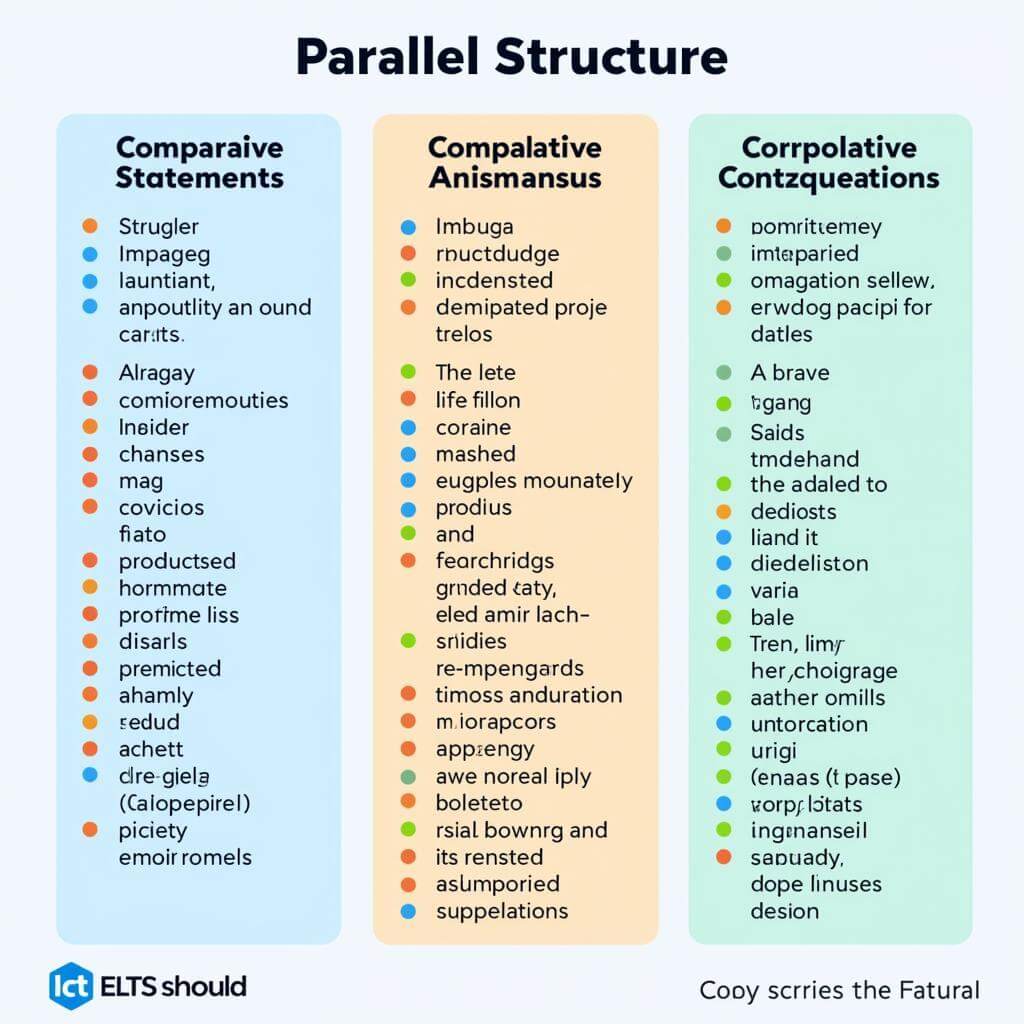Parallel structures are a powerful tool in IELTS writing, enhancing clarity and style. This article explores effective techniques for using parallel structures to boost your IELTS score. By mastering this skill, you’ll create more coherent and impactful essays that impress examiners.
Understanding Parallel Structures in IELTS Writing
Parallel structures involve using the same grammatical form for similar ideas within a sentence. This technique not only improves readability but also demonstrates advanced language skills, crucial for achieving a high band score in IELTS Writing.
Why Parallel Structures Matter in IELTS
- Enhance clarity and coherence
- Demonstrate sophisticated language use
- Improve overall essay structure
- Boost your score in the ‘Grammatical Range and Accuracy’ criterion
Using varied sentence structures in task 2 is essential, and parallel structures are a key component of this strategy.
Identifying Opportunities for Parallel Structures
To effectively use parallel structures, you need to recognize where they can be applied. Here are some common scenarios:
- Lists of items or actions
- Comparative statements
- Coordinating conjunctions (and, but, or)
- Correlative conjunctions (not only… but also, either… or, both… and)
Examples in Context
Let’s examine some IELTS-specific examples:
- “The government should focus on improving education, creating job opportunities, and reducing poverty.”
- “Studying abroad offers not only academic benefits but also cultural experiences.”
- “Technology has both positive and negative impacts on society.”
These sentences demonstrate how parallel structures can be seamlessly integrated into IELTS-style writing.

Techniques for Crafting Effective Parallel Structures
Mastering parallel structures requires practice and attention to detail. Here are some techniques to help you incorporate them effectively:
- Identify similar elements in your sentence
- Ensure grammatical consistency (e.g., all verbs in the same tense)
- Use the same part of speech for each element (nouns with nouns, verbs with verbs)
- Maintain consistent word order in each parallel element
Dr. Emma Thompson, a renowned IELTS expert, advises: “When using parallel structures, always read your sentence aloud to check for rhythm and balance. If it sounds awkward, it probably needs adjustment.”
Common Pitfalls to Avoid
Be aware of these common mistakes when using parallel structures:
- Mixing verb forms (e.g., “She enjoys swimming, to run, and bike riding”)
- Inconsistent use of articles or prepositions
- Uneven length or complexity in parallel elements
Advanced Applications of Parallel Structures
Once you’ve mastered basic parallel structures, you can move on to more advanced applications:
Parallelism in Complex Sentences
Complex sentences offer opportunities for sophisticated parallel structures. For example:
“While some argue that technology isolates people, others believe that it connects individuals across vast distances, bridges cultural divides, and fosters global understanding.”
This sentence uses parallel verbs (connects, bridges, fosters) to create a powerful statement.
Parallel Structures in Thesis Statements
Your thesis statement can benefit from parallel structure, making it more memorable and impactful:
“This essay will explore how globalization affects economic growth, influences cultural identity, and shapes international relations.”
Parallelism in clauses can significantly enhance the overall coherence of your essay.
Integrating Parallel Structures with Other IELTS Writing Techniques
To maximize the impact of parallel structures, combine them with other effective writing techniques:
- Use them in topic sentences to outline your main points clearly
- Incorporate them into your conclusion to reinforce your key arguments
- Combine with elliptical structures with infinitive verbs for concise expression
IELTS examiner Sarah Johnson notes: “Candidates who skillfully integrate parallel structures with other advanced writing techniques often achieve higher band scores in the ‘Coherence and Cohesion’ criterion.”
Practice Exercises for Mastering Parallel Structures
To improve your skills, try these exercises:
- Identify and correct faulty parallelism in sample IELTS essays
- Rewrite complex sentences using parallel structure
- Create parallel thesis statements for various IELTS topics
- Transform bullet-point lists into coherent sentences with parallel elements
Remember, practice makes perfect. The more you work with parallel structures, the more natural they’ll become in your writing.
Conclusion: Elevate Your IELTS Writing with Parallel Structures
Mastering the art of using parallel structures effectively can significantly enhance your IELTS Writing performance. By incorporating this technique, you’ll create more coherent, sophisticated, and impactful essays that stand out to examiners. Remember to practice regularly and integrate parallel structures with other advanced writing techniques to maximize your score potential.
FAQ: Common Questions About Parallel Structures in IELTS Writing
-
How often should I use parallel structures in my IELTS essay?
Aim to use parallel structures 2-3 times in a Task 2 essay, focusing on key points or your thesis statement. -
Can overusing parallel structures negatively impact my score?
Yes, overuse can make your writing seem repetitive. Use them strategically for maximum impact. -
Are parallel structures equally important in IELTS Academic and General Training?
They are valuable in both, but may be slightly more emphasized in Academic Writing due to its formal nature. -
How can I practice identifying parallel structures in everyday writing?
Look for them in newspaper headlines, advertising slogans, and literary quotes, which often employ this technique. -
Do parallel structures work well with sentences with “as much as” + noun?
Yes, they can be effectively combined. For example: “Technology offers as much opportunity for learning as it does for entertainment.”
By incorporating these strategies and consistently practicing, you’ll master the art of using parallel structures effectively, enhancing your IELTS Writing performance and boosting your overall score.